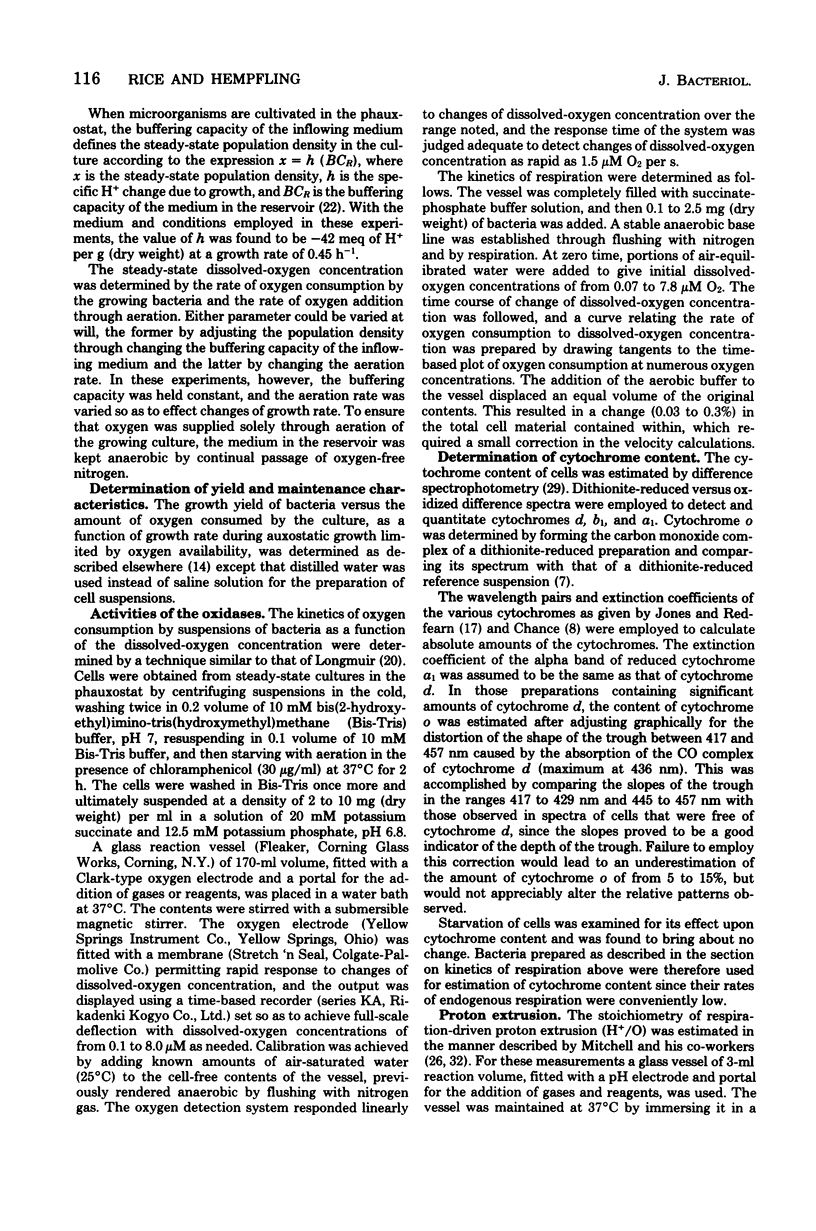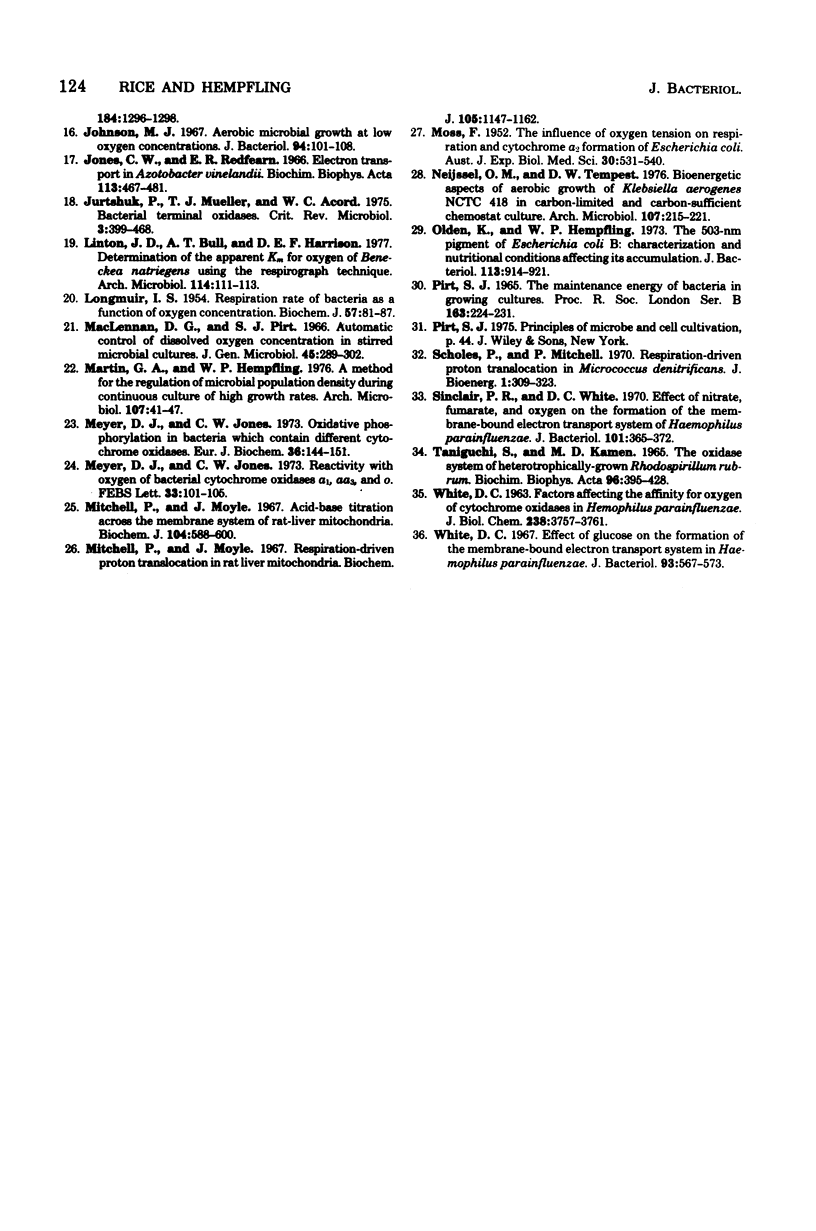Abstract
Escherichia coli B was cultured continuously in succinate-minimal medium under conditions of oxygen limitation in the phauxostat. With decreasing oxygenation and consequent decreasing growth rates, the complement of terminal cytochrome oxidases changed as follows: high growth rates, cytochrome o; intermediate growth rates, cytochromes o and d; lowest growth rates, cytochromes o, d, and a1. Respiratory kinetics exhibited by nongrowing cell suspensions obtained from continuous cultures indicated that terminal oxidase activity was exhibited by cytochrome o (Km for O2 = 0.2 micron; Vmax = 1.1 to 1.5 mumol of O2 per nmol of cytochrome o per min) and cytochrome d (Km for O2 = 0.024 micron; Vmax = 0.7 mumol of O2 per nmol of cytochrome d per min). During oxygen-limited growth, the molar growth yield referred to respiration, and corrected for maintenance respiration [Yo(max)], was 12.6 g (dry weight) per g-atom of oxygen, not significantly different from the succinate-limited value of 12.0 g (dry weight) per g-atom of oxygen. The rate of maintenance respiration of the oxygen-limited culture was only 3.4 mg-atoms of O per g (dry weight) per h, some threefold less than that of the succinate-limited culture. Respiration-driven proton extrusion did not vary with the growth rate or with the complement of terminal oxidases (H+/O = 3.7; standard deviation, 0.07). We conclude that the content of terminal oxidases is without effect on the efficiency of respiratory energy conservation.
Full text
PDF









Selected References
These references are in PubMed. This may not be the complete list of references from this article.
- Arima K., Oka T. Cyanide Resistance in Achromobacter I. Induced Formation of Cytochrome a(2) and Its Role in Cyanide-Resistant Respiration. J Bacteriol. 1965 Sep;90(3):734–743. doi: 10.1128/jb.90.3.734-743.1965. [DOI] [PMC free article] [PubMed] [Google Scholar]
- Ashcroft J. R., Haddock B. A. Synthesis of alternative membrane-bound redox carriers during aerobic growth of Escherichia coli in the presence of potassium cyanide. Biochem J. 1975 May;148(2):349–352. doi: 10.1042/bj1480349. [DOI] [PMC free article] [PubMed] [Google Scholar]
- Brand M. D., Reynafarje B., Lehninger A. L. Stoichiometric relationship between energy-dependent proton ejection and electron transport in mitochondria. Proc Natl Acad Sci U S A. 1976 Feb;73(2):437–441. doi: 10.1073/pnas.73.2.437. [DOI] [PMC free article] [PubMed] [Google Scholar]
- Button D. K., Garver J. C. Continuous culture of Torulopsis utilis: a kinetic study of oxygen limited growth. J Gen Microbiol. 1966 Nov;45(2):195–204. doi: 10.1099/00221287-45-2-195. [DOI] [PubMed] [Google Scholar]
- CASTOR L. N., CHANCE B. Photochemical determinations of the oxidases of bacteria. J Biol Chem. 1959 Jun;234(6):1587–1592. [PubMed] [Google Scholar]
- CHANCE B. Cellular oxygen requirements. Fed Proc. 1957 Sep;16(3):671–680. [PubMed] [Google Scholar]
- FINN R. K. Agitation-aeration in the laboratory and in industry. Bacteriol Rev. 1954 Dec;18(4):254–274. doi: 10.1128/br.18.4.254-274.1954. [DOI] [PMC free article] [PubMed] [Google Scholar]
- Haddock B. A., Downie J. A., Garland P. B. Kinetic characterization of the membrane-bound cytochromes of Escherichia coli grown under a variety of conditions by using a stopped-flow dual-wavelength spectrophotometer. Biochem J. 1976 Feb 15;154(2):285–294. doi: 10.1042/bj1540285. [DOI] [PMC free article] [PubMed] [Google Scholar]
- Harrison D. E. The regulation of respiration rate in growing bacteria. Adv Microb Physiol. 1976;14(11):243–313. doi: 10.1016/s0065-2911(08)60229-5. [DOI] [PubMed] [Google Scholar]
- Hempfling W. P., Mainzer S. E. Effects of varying the carbon source limiting growth on yield and maintenance characteristics of Escherichia coli in continuous culture. J Bacteriol. 1975 Sep;123(3):1076–1087. doi: 10.1128/jb.123.3.1076-1087.1975. [DOI] [PMC free article] [PubMed] [Google Scholar]
- Hempfling W. P. Repression of oxidative phosphorylation in Escherichia coli B by growth in glucose and other carbohydrates. Biochem Biophys Res Commun. 1970 Oct 9;41(1):9–15. doi: 10.1016/0006-291x(70)90461-4. [DOI] [PubMed] [Google Scholar]
- Johnson M. J. Aerobic microbial growth at low oxygen concentrations. J Bacteriol. 1967 Jul;94(1):101–108. doi: 10.1128/jb.94.1.101-108.1967. [DOI] [PMC free article] [PubMed] [Google Scholar]
- Jones C. W., Redfearn E. R. Electron transport in Azotobacter vinelandii. Biochim Biophys Acta. 1966 Mar 7;113(3):467–481. doi: 10.1016/s0926-6593(66)80005-x. [DOI] [PubMed] [Google Scholar]
- LONGMUIR I. S. Respiration rate of bacteria as a function of oxygen concentration. Biochem J. 1954 May;57(1):81–87. doi: 10.1042/bj0570081. [DOI] [PMC free article] [PubMed] [Google Scholar]
- MOSS F. The influence of oxygen tension on respiration and cytochrome a2 formation of Escherichia coli. Aust J Exp Biol Med Sci. 1952 Dec;30(6):531–540. doi: 10.1038/icb.1952.51. [DOI] [PubMed] [Google Scholar]
- MacLennan D. G., Pirt S. J. Automatic control of dissolved oxygen concentration in stirred microbial cultures. J Gen Microbiol. 1966 Nov;45(2):289–302. doi: 10.1099/00221287-45-2-289. [DOI] [PubMed] [Google Scholar]
- Martin G. A., Hempfling W. P. A method for the regulation of microbial population density during continuous culture at high growth rates. Arch Microbiol. 1976 Feb;107(1):41–47. doi: 10.1007/BF00427865. [DOI] [PubMed] [Google Scholar]
- Meyer D. J., Jones C. W. Oxidative phosphorylation in bacteria which contain different cytochrome oxidases. Eur J Biochem. 1973 Jul 2;36(1):144–151. doi: 10.1111/j.1432-1033.1973.tb02894.x. [DOI] [PubMed] [Google Scholar]
- Meyer D. J., Jones C. W. Reactivity with oxygen of bacterial cytochrome oxidases a1, aa3 and o. FEBS Lett. 1973 Jun 15;33(1):101–105. doi: 10.1016/0014-5793(73)80169-3. [DOI] [PubMed] [Google Scholar]
- Mitchell P., Moyle J. Acid-base titration across the membrane system of rat-liver mitochondria. Catalysis by uncouplers. Biochem J. 1967 Aug;104(2):588–600. doi: 10.1042/bj1040588. [DOI] [PMC free article] [PubMed] [Google Scholar]
- Mitchell P., Moyle J. Respiration-driven proton translocation in rat liver mitochondria. Biochem J. 1967 Dec;105(3):1147–1162. doi: 10.1042/bj1051147. [DOI] [PMC free article] [PubMed] [Google Scholar]
- Neijssel O. M., Tempest D. W. Bioenergetic aspects of aerobic growth of Klebsiella aerogenes NCTC 418 in carbon-limited and carbon-sufficient chemostat culture. Arch Microbiol. 1976 Mar 19;107(2):215–221. doi: 10.1007/BF00446843. [DOI] [PubMed] [Google Scholar]
- Olden K., Hempfling W. P. The 503-nm pigment of Escherichia coli B: characterization and nutritional conditions affecting its accumulation. J Bacteriol. 1973 Feb;113(2):914–921. doi: 10.1128/jb.113.2.914-921.1973. [DOI] [PMC free article] [PubMed] [Google Scholar]
- Pirt S. J. The maintenance energy of bacteria in growing cultures. Proc R Soc Lond B Biol Sci. 1965 Oct 12;163(991):224–231. doi: 10.1098/rspb.1965.0069. [DOI] [PubMed] [Google Scholar]
- Scholes P., Mitchell P. Respiration-driven proton translocation in Micrococcus denitrificans. J Bioenerg. 1971 Sep;1(3):309–323. doi: 10.1007/BF01516290. [DOI] [PubMed] [Google Scholar]
- Sinclair P. R., White D. C. Effect of nitrate, fumarate, and oxygen on the formation of the membrane-bound electron transport system of Haemophilus parainfluenzae. J Bacteriol. 1970 Feb;101(2):365–372. doi: 10.1128/jb.101.2.365-372.1970. [DOI] [PMC free article] [PubMed] [Google Scholar]
- TANIGUCHI S., KAMEN M. D. THE OXIDASE SYSTEM OF HETEROTROPHICALLY-GROWN RHODOSPIRILLUM RUBRUM. Biochim Biophys Acta. 1965 Mar 22;96:395–428. doi: 10.1016/0005-2787(65)90560-5. [DOI] [PubMed] [Google Scholar]
- WHITE D. C. FACTORS AFFECTING THE AFFINITY FOR OXYGEN OF CYTOCHROME OXIDASES IN HEMOPHILUS PARAINFLUENZAE. J Biol Chem. 1963 Nov;238:3757–3761. [PubMed] [Google Scholar]
- White D. C. Effect of glucose on the formation of the membrane-bound electron transport system in Haemophilus parainfluenzae. J Bacteriol. 1967 Feb;93(2):567–573. doi: 10.1128/jb.93.2.567-573.1967. [DOI] [PMC free article] [PubMed] [Google Scholar]


